How Many Food Insecure In America? Understanding the scope of food insecurity in the United States is crucial, and FOODS.EDU.VN is here to provide you with a comprehensive analysis and explore potential solutions. We will delve into recent data, trends, and household characteristics related to food insecurity, offering insights into the challenges faced by millions and showcasing the resources available to overcome them. Discover a wealth of culinary knowledge and nutritional wisdom at FOODS.EDU.VN, including nutritious recipes, ingredient guides, and expert cooking techniques.
1. Understanding Food Insecurity in the United States
Food insecurity is a complex issue characterized by limited or uncertain access to adequate food. This can stem from a lack of financial resources or other limitations. It’s important to differentiate between low food security and very low food security.
- Food Secure: Households with consistent access to sufficient food for an active, healthy life for all members.
- Food Insecure: Households that, at some point during the year, lacked sufficient money or resources for adequate food.
- Low Food Security: Households that managed to avoid significant disruptions to their eating patterns by implementing strategies like consuming less varied diets or utilizing food assistance programs.
- Very Low Food Security: Households where one or more members experienced disrupted eating patterns and reduced food intake due to lack of resources.
2. Key Statistics on Food Insecurity in 2023
Recent data provides a snapshot of food insecurity in the U.S. Let’s examine the key findings:
- Overall Food Security: In 2023, 86.5% (114.6 million) of U.S. households were food secure.
- Overall Food Insecurity: 13.5% (18.0 million) of U.S. households experienced food insecurity at some point during the year.
- Low Food Security: 8.4% (11.2 million) of households had low food security.
- Very Low Food Security: 5.1% (6.8 million) of households experienced very low food security.
The prevalence of food insecurity in 2023 was statistically significantly higher than the 12.8 percent in 2022.
3. Food Insecurity Among Households with Children
Food insecurity disproportionately affects households with children. Understanding the specific challenges these families face is essential.
- Food Secure Households with Children: 82.1% (29.7 million) of households with children were food secure in 2023.
- Food Insecure Households with Children: 17.9% (6.5 million) of households with children experienced food insecurity.
- Adults Only Food Insecurity: In 9.0% (3.3 million) of households with children, only adults were food insecure.
- Children and Adults Food Insecurity: Both children and adults were food insecure in 8.9% of households with children (3.2 million households).
- Children Experiencing Reduced Food Intake: Approximately 1.0% of households with children (374,000 households) reported that one or more child experienced reduced food intake and disrupted eating patterns.
4. Impact on Individuals: How Many People are Affected?
Beyond household statistics, it’s crucial to understand the number of individuals affected by food insecurity.
- Total People in Food-Insecure Households: 47.4 million people lived in food-insecure households in 2023.
- Adults in Households with Very Low Food Security: 12.2 million adults lived in households with very low food security.
- Children in Food-Insecure Households: 7.2 million children lived in food-insecure households where both children and adults were food insecure.
- Children Experiencing Very Low Food Security: 841,000 children (1.2% of the nation’s children) lived in households where they experienced very low food security.
5. Disparities in Food Insecurity by Household Characteristics
Food insecurity doesn’t affect all populations equally. Certain household characteristics are associated with higher rates of food insecurity. The prevalence of household food insecurity in 2023 was statistically higher than the prevalence in 2022 for a number of populations.
| Household Characteristic | 2022 Prevalence (%) | 2023 Prevalence (%) |
|---|---|---|
| All Households | 12.8 | 13.5 |
| Households with Children | 16.7 | 17.9 |
| Households without Children | 11.6 | 12.3 |
| Married Couple Households | 7.5 | 8.0 |
| Single Mother Households | 32.7 | 34.5 |
| Black, Non-Hispanic Households | 20.7 | 22.5 |
| Hispanic Households | 18.9 | 20.8 |
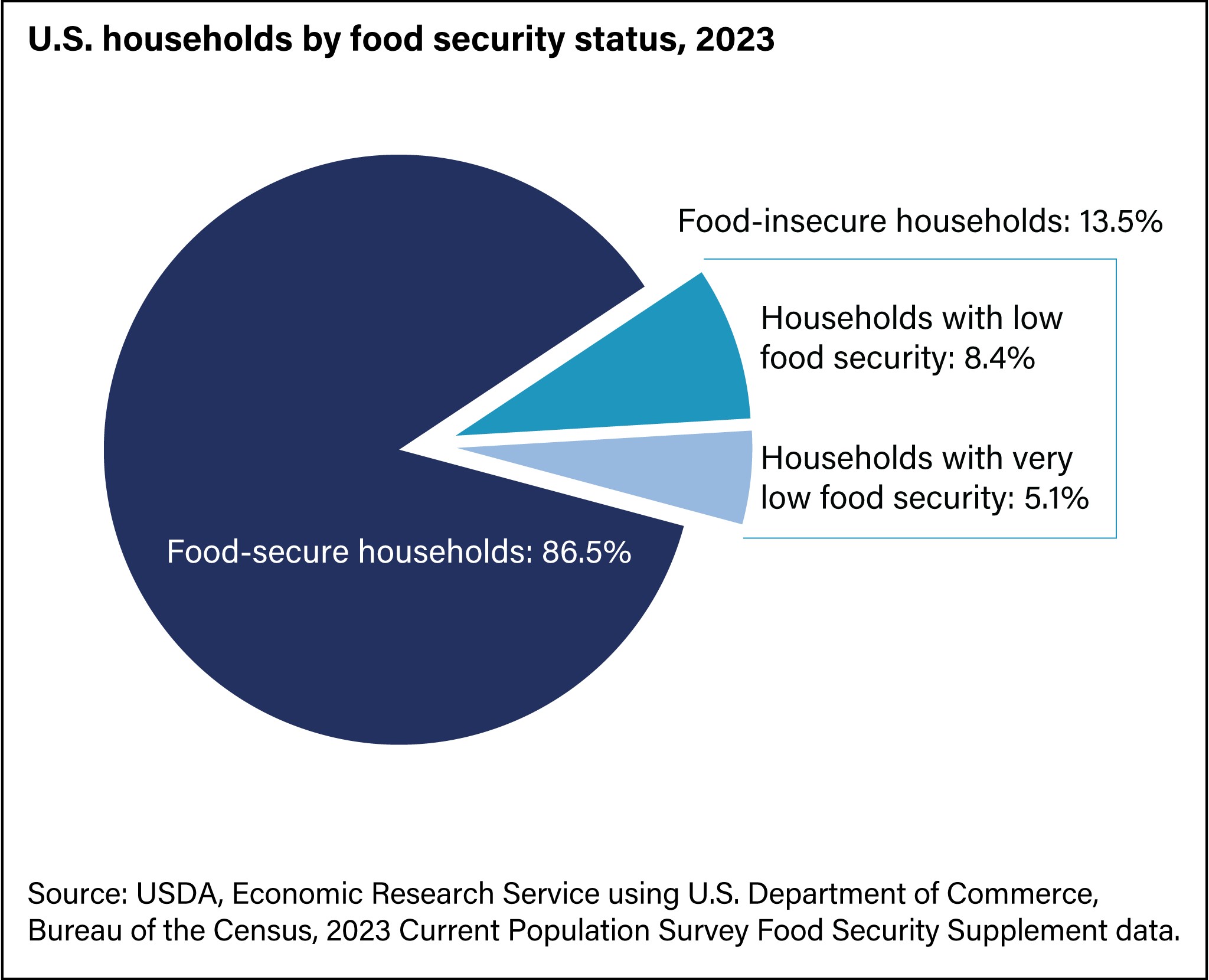
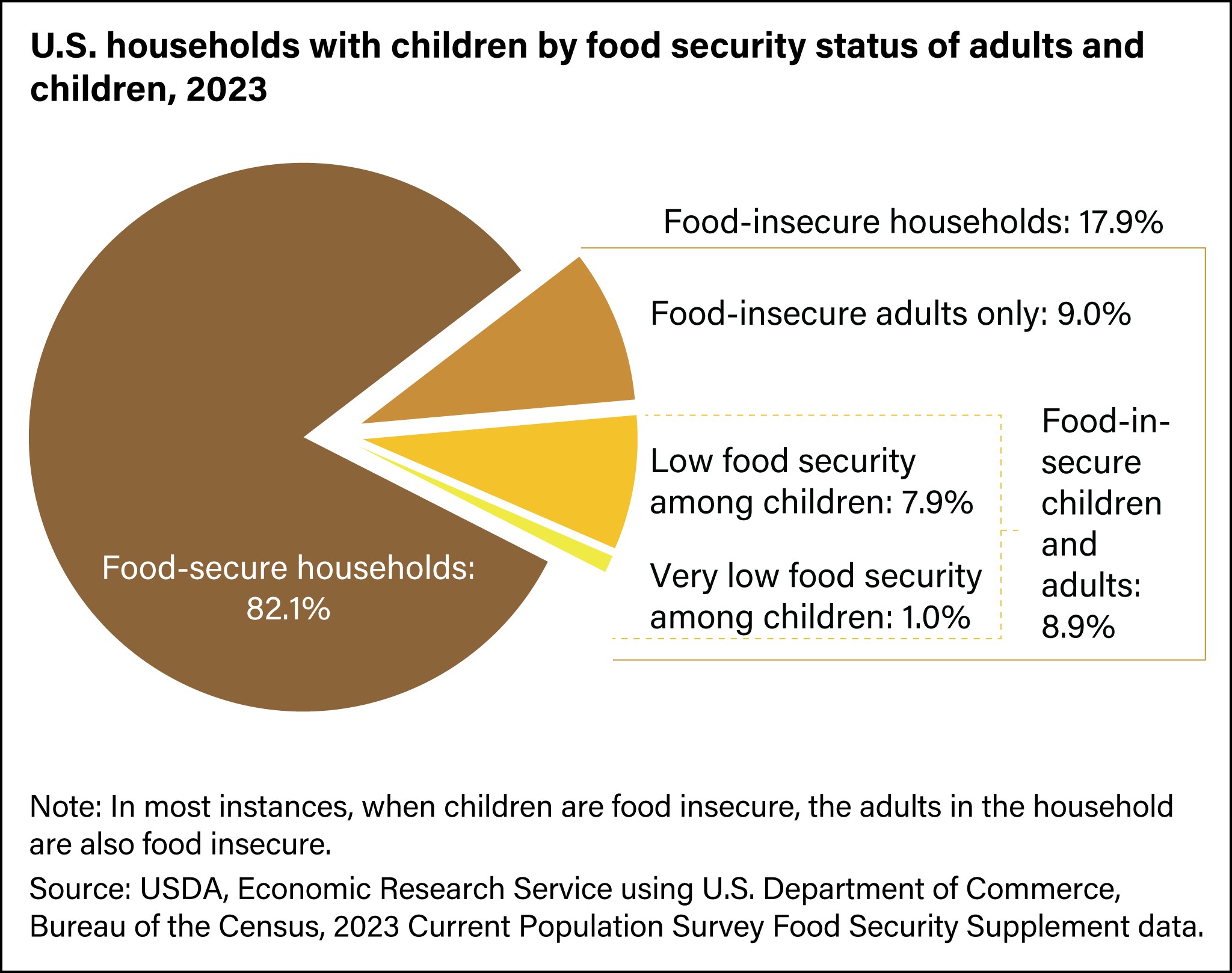
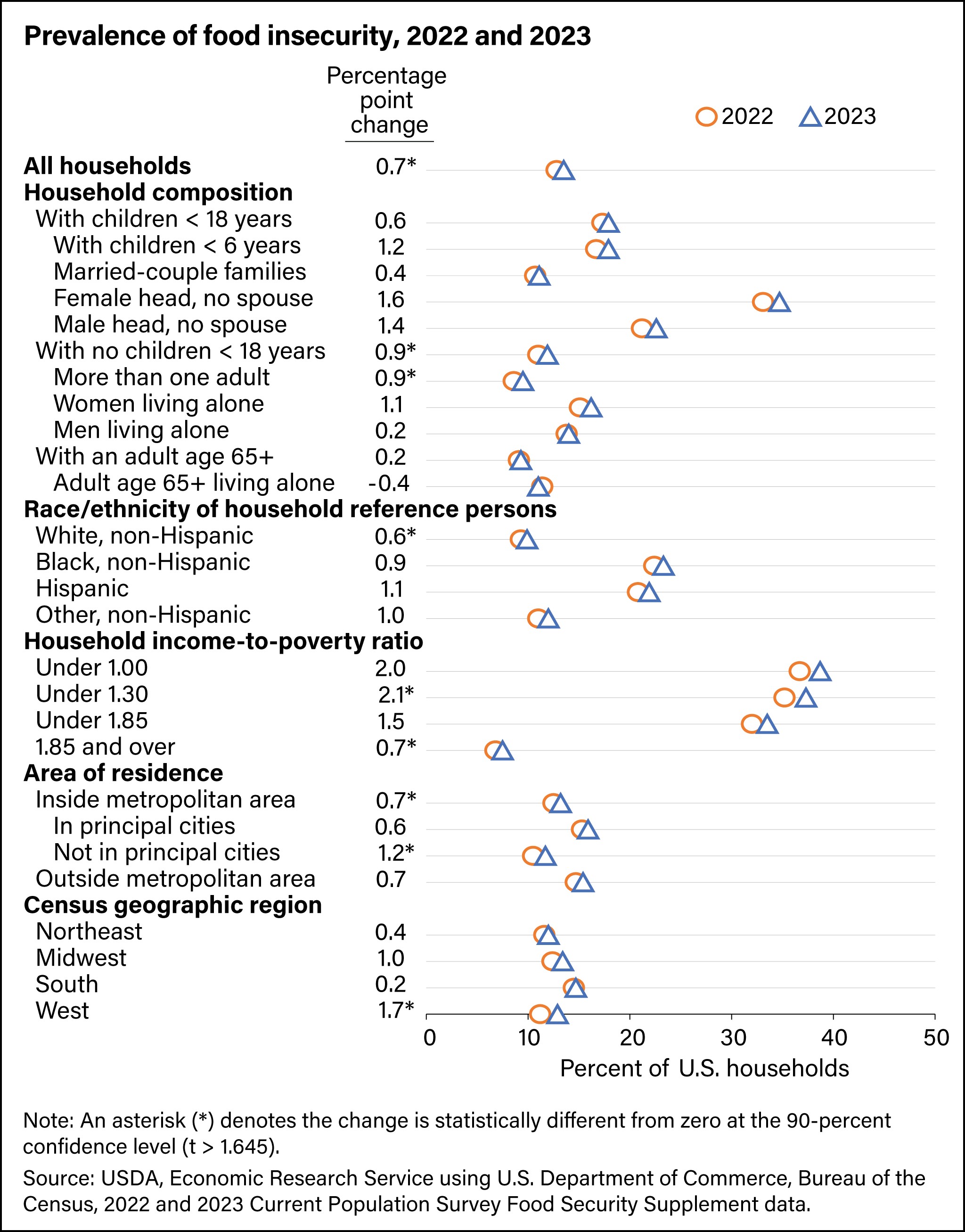
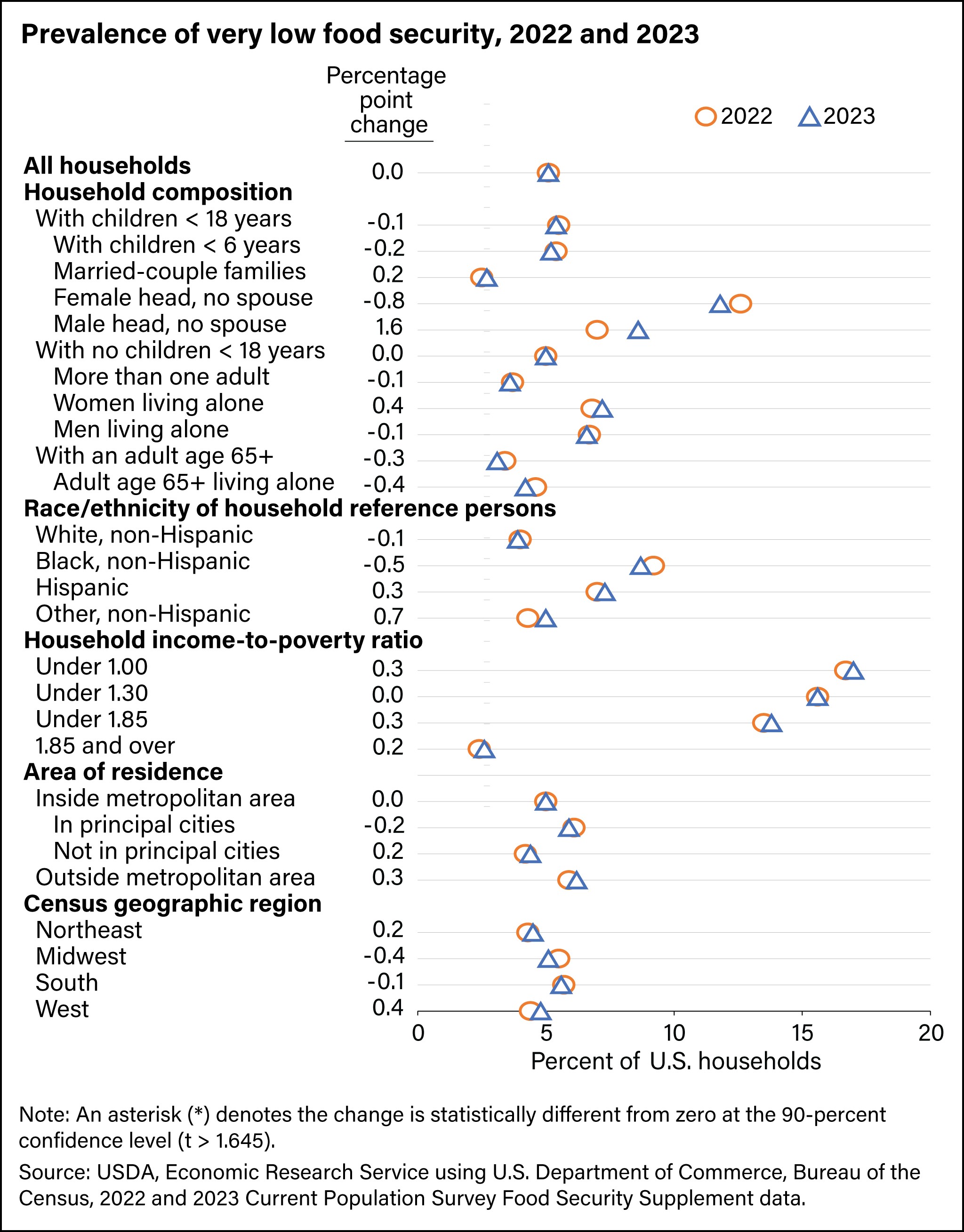
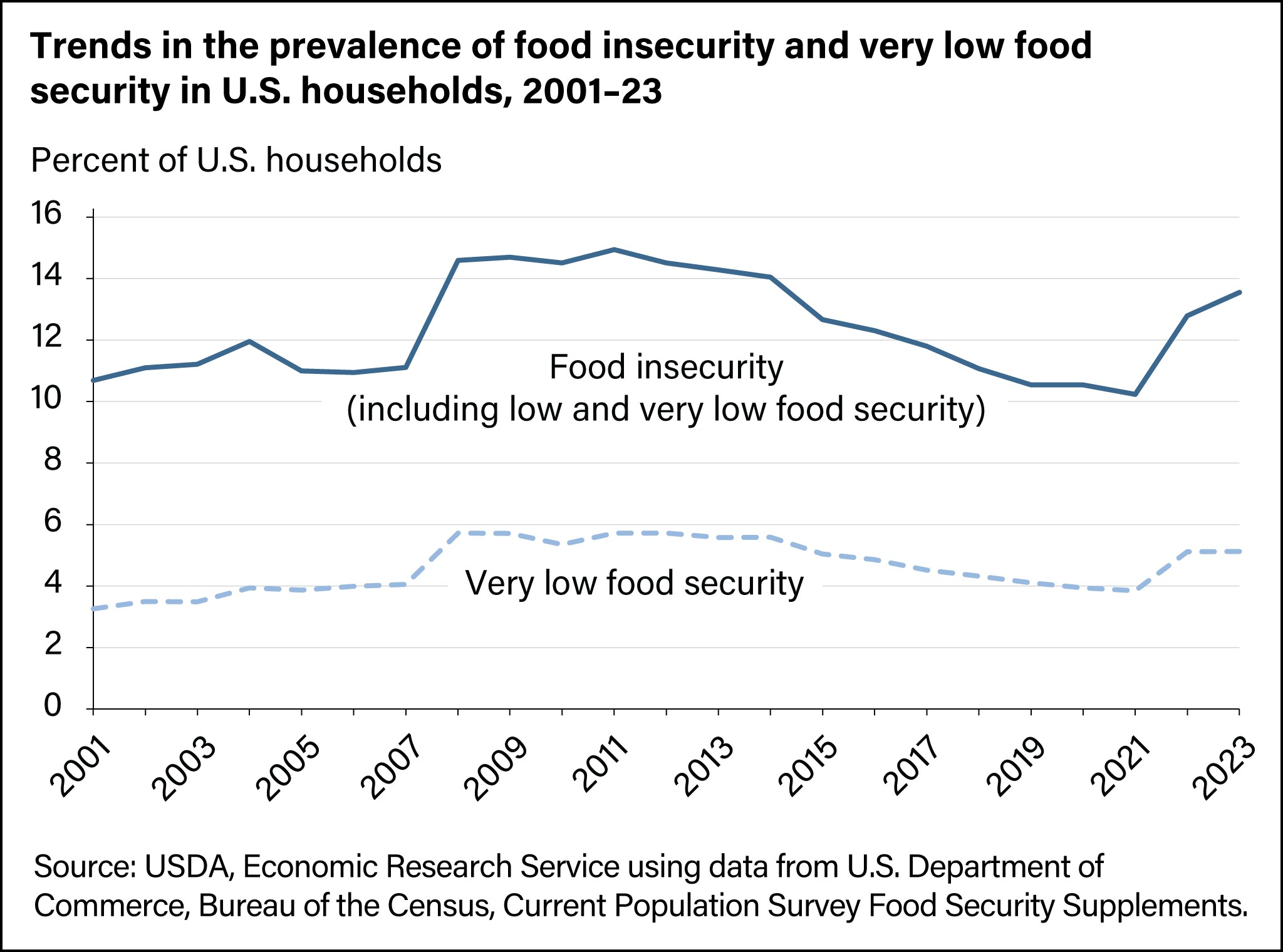

6. Very Low Food Security: A Deeper Dive into Vulnerability
Examining very low food security provides a more granular understanding of the most severe cases.
| Household Characteristic | 2022 Prevalence (%) | 2023 Prevalence (%) |
|---|---|---|
| All Households | 5.1 | 5.1 |
| Households with Children | 6.3 | 6.5 |
| Households without Children | 4.7 | 4.7 |
| Married Couple Households | 2.2 | 2.2 |
| Single Mother Households | 12.0 | 12.1 |
| Black, Non-Hispanic Households | 9.6 | 9.7 |
| Hispanic Households | 6.9 | 6.9 |
7. Analyzing Trends in Food Insecurity Rates
Understanding historical trends is vital for assessing progress and identifying areas needing more attention.
- Recent Increase: The 2023 food insecurity rate (13.5%) was statistically significantly higher than the 2022 rate (12.8%).
- Comparison to Previous Years: The 2023 rate was significantly higher than rates observed from 2015 through 2022 but lower than rates from 2010 through 2014.
- Pre-Recession Levels: In 2019, food insecurity was statistically significantly below the 2007 pre-recession level (11.1%).
- Long-Term Trends: Food insecurity increased from 10.7% in 2001 to 11.9% in 2004, then rose significantly in 2008 (to 14.6%) during the recession.
The prevalence of very low food security in 2023 (5.1 percent) was statistically unchanged from the prevalence in 2022 (5.1 percent) but was statistically significantly higher than the annual prevalence from 2017 through 2021.
8. State-Level Variations in Food Insecurity
Food insecurity rates vary significantly across different states, reflecting regional economic and social conditions. Combining data from 2021-2023 provides more reliable state-level statistics.
- Highest Rate: Arkansas had the highest food insecurity rate at 18.9%.
- Lowest Rate: New Hampshire had the lowest food insecurity rate at 7.4%.
- Very Low Food Security Range: Very low food security rates ranged from 3.2% in Iowa, Massachusetts, New Hampshire, New Jersey, and North Dakota to 7.0% in South Carolina.
9. Factors Contributing to Food Insecurity
Several factors contribute to food insecurity in America. Understanding these drivers is crucial for developing effective solutions.
- Poverty: Low income is a primary driver of food insecurity. Families struggling to afford basic necessities often have to make difficult choices between food and other essential expenses.
- Unemployment: Job loss can quickly lead to food insecurity, especially for families without savings or other resources to fall back on.
- Lack of Affordable Housing: High housing costs can strain household budgets, leaving less money for food.
- Health Issues: Medical expenses and disabilities can reduce income and increase the risk of food insecurity.
- Limited Access to Resources: Lack of transportation, living in a food desert (an area with limited access to affordable and nutritious food), and limited awareness of available assistance programs can all contribute to food insecurity.
- Systemic Inequality: Racial and ethnic disparities in income, wealth, and access to resources contribute to higher rates of food insecurity among certain populations.
10. Government Programs and Initiatives Addressing Food Insecurity
The U.S. government has several programs designed to combat food insecurity and provide assistance to vulnerable populations.
- Supplemental Nutrition Assistance Program (SNAP): SNAP provides low-income individuals and families with monthly benefits to purchase food. It is the largest federal nutrition assistance program.
- Special Supplemental Nutrition Program for Women, Infants, and Children (WIC): WIC provides nutritious foods, nutrition education, and healthcare referrals to low-income pregnant, postpartum, and breastfeeding women, infants, and children up to age 5 who are at nutritional risk.
- National School Lunch Program (NSLP) and School Breakfast Program (SBP): These programs provide free or reduced-price meals to eligible children in schools.
- Child and Adult Care Food Program (CACFP): CACFP provides nutritious meals and snacks to children and adults in daycare settings.
- The Emergency Food Assistance Program (TEFAP): TEFAP provides food to food banks and other emergency food providers for distribution to low-income individuals and families.
11. The Role of Food Banks and Charitable Organizations
Food banks and charitable organizations play a vital role in addressing food insecurity at the local level.
- Food Banks: Food banks collect, store, and distribute food to food pantries, soup kitchens, and other organizations that directly serve individuals and families in need.
- Food Pantries: Food pantries provide groceries and other food items directly to individuals and families.
- Soup Kitchens: Soup kitchens offer free meals to people in need.
- Meal Delivery Programs: Programs like Meals on Wheels deliver meals to seniors and individuals with disabilities who are unable to prepare their own food.
- Community Gardens: Community gardens provide opportunities for people to grow their own food and increase access to fresh produce.
12. Innovative Approaches to Combating Food Insecurity
Beyond traditional programs, innovative approaches are emerging to address food insecurity in new and effective ways.
- Mobile Food Pantries: Mobile food pantries bring food directly to underserved communities, overcoming transportation barriers.
- Online Food Ordering and Delivery: Some food banks and pantries are offering online ordering and delivery services, making it easier for people to access food.
- Nutrition Education Programs: Programs that teach people how to shop for healthy food on a budget and prepare nutritious meals can help them make the most of their limited resources.
- Job Training and Employment Programs: Addressing the root causes of food insecurity by helping people find employment and increase their income is essential.
- Food Waste Reduction Initiatives: Reducing food waste at all levels, from farms to households, can increase the availability of food and reduce the environmental impact of food production.
- Technology Solutions: Apps and online platforms can connect people with food resources, provide information about available assistance programs, and facilitate food donations.
13. The Connection Between Food Insecurity and Health
Food insecurity has significant health consequences.
- Poor Nutrition: Limited access to nutritious food can lead to nutrient deficiencies, obesity, and other health problems.
- Chronic Diseases: Food insecurity is associated with an increased risk of chronic diseases such as diabetes, heart disease, and high blood pressure.
- Mental Health Issues: Food insecurity can contribute to stress, anxiety, and depression.
- Developmental Problems in Children: Food insecurity can negatively impact children’s physical and cognitive development.
- Increased Healthcare Costs: The health consequences of food insecurity can lead to increased healthcare costs for individuals and the healthcare system.
14. Community-Based Solutions and Initiatives
Local communities are often at the forefront of addressing food insecurity through grassroots initiatives.
- Community Gardens and Farms: These initiatives increase access to fresh produce and provide opportunities for community members to learn about gardening and nutrition.
- Food Co-ops: Food co-ops offer affordable groceries to members and support local farmers.
- Community Kitchens: Community kitchens provide a space for people to prepare and share meals, reducing social isolation and promoting healthy eating.
- Cooking Classes and Workshops: These programs teach people how to cook healthy meals on a budget and make the most of available resources.
- Food Policy Councils: Food policy councils bring together community stakeholders to address food system issues and advocate for policies that promote food security.
15. Strategies for Individuals and Families Facing Food Insecurity
If you or someone you know is facing food insecurity, several strategies can help.
- Apply for SNAP and WIC: These programs can provide significant assistance with purchasing food.
- Visit a Food Bank or Pantry: Food banks and pantries offer free groceries and other food items to people in need.
- Find Free Meals: Soup kitchens and other organizations offer free meals to people in need.
- Look for Community Resources: Many communities offer cooking classes, nutrition education programs, and other resources to help people access affordable and nutritious food.
- Shop Smart: Plan meals, make a grocery list, and compare prices to get the most for your money.
- Cook at Home: Eating at home is generally more affordable than eating out.
- Grow Your Own Food: Even a small garden can provide fresh produce and save money on groceries.
- Connect with Others: Sharing meals and resources with friends, family, and neighbors can help reduce food costs and build a stronger community.
16. The Long-Term Economic Impact of Food Insecurity
Food insecurity has far-reaching economic consequences.
- Reduced Productivity: Food-insecure individuals may be less productive at work or school due to poor health and lack of energy.
- Increased Healthcare Costs: The health consequences of food insecurity lead to increased healthcare costs for individuals and the healthcare system.
- Educational Attainment: Food insecurity can negatively impact children’s educational attainment, limiting their future opportunities.
- Economic Mobility: Food insecurity can trap families in a cycle of poverty, making it difficult for them to improve their economic circumstances.
- Strain on Social Safety Net: High rates of food insecurity place a strain on government assistance programs and charitable organizations.
17. Addressing Food Deserts and Improving Food Access
Food deserts, areas with limited access to affordable and nutritious food, are a significant contributor to food insecurity.
- Attracting Grocery Stores: Incentivizing grocery stores to open in underserved areas can increase access to fresh produce and other healthy foods.
- Supporting Farmers Markets: Farmers markets provide access to locally grown produce and support local farmers.
- Mobile Food Markets: Mobile food markets bring fresh produce to underserved communities on a regular basis.
- Community Gardens and Farms: Community gardens and farms can increase access to fresh produce and provide opportunities for people to grow their own food.
- Improving Transportation: Improving public transportation and providing transportation assistance can help people access grocery stores and other food resources.
- Online Grocery Ordering and Delivery: Offering online grocery ordering and delivery services can make it easier for people to access food, especially those with limited transportation or mobility.
18. Policy Recommendations for Reducing Food Insecurity
Effective policy interventions are essential for addressing the root causes of food insecurity.
- Strengthening SNAP and WIC: Increasing benefits, expanding eligibility, and improving access to these programs can help more families afford food.
- Raising the Minimum Wage: Increasing the minimum wage can help low-income workers earn enough to afford basic necessities, including food.
- Expanding Access to Affordable Housing: Reducing housing costs can free up household budgets for food and other essential expenses.
- Investing in Education and Job Training: Improving educational opportunities and job training programs can help people find employment and increase their income.
- Addressing Systemic Inequality: Policies that address racial and ethnic disparities in income, wealth, and access to resources can help reduce food insecurity among vulnerable populations.
- Supporting Food Banks and Charitable Organizations: Providing funding and resources to food banks and other charitable organizations can help them meet the increasing demand for food assistance.
19. The Role of Technology in Alleviating Food Insecurity
Technology offers powerful tools for addressing food insecurity.
- Mobile Apps: Apps can connect people with food resources, provide information about available assistance programs, and facilitate food donations.
- Online Platforms: Online platforms can enable food banks and pantries to manage their inventory, coordinate volunteers, and communicate with clients.
- Data Analytics: Data analytics can be used to identify areas with high rates of food insecurity and target interventions effectively.
- Blockchain Technology: Blockchain technology can be used to track food donations and ensure that they reach the people who need them most.
- Artificial Intelligence: AI can be used to optimize food distribution and reduce food waste.
20. Promoting Nutrition Education and Healthy Eating Habits
Nutrition education is crucial for empowering individuals and families to make healthy food choices on a budget.
- Cooking Classes: Cooking classes teach people how to prepare healthy meals using affordable ingredients.
- Nutrition Workshops: Nutrition workshops provide information about healthy eating habits and how to make informed food choices.
- Community Gardens: Community gardens provide opportunities for people to learn about gardening and nutrition.
- Educational Materials: Providing educational materials about healthy eating and food budgeting can help people make the most of their limited resources.
- Social Media Campaigns: Social media campaigns can be used to promote healthy eating habits and raise awareness about food insecurity.
21. Addressing the Stigma Associated with Food Insecurity
Many people who are food insecure experience stigma and shame, which can prevent them from seeking help.
- Raising Awareness: Raising awareness about food insecurity and its causes can help reduce stigma and promote understanding.
- Using Respectful Language: Using respectful and non-judgmental language when discussing food insecurity can help create a more supportive environment.
- Sharing Personal Stories: Sharing personal stories about overcoming food insecurity can help reduce stigma and inspire others to seek help.
- Creating Welcoming Environments: Ensuring that food banks and pantries are welcoming and non-judgmental can encourage people to seek assistance.
- Advocating for Policy Changes: Advocating for policy changes that address the root causes of food insecurity can help create a more equitable and just society.
22. Measuring the Impact of Food Insecurity Interventions
It’s crucial to measure the impact of food insecurity interventions to ensure that they are effective and efficient.
- Tracking Food Security Rates: Monitoring food security rates over time can help assess the overall impact of interventions.
- Evaluating Program Outcomes: Evaluating the outcomes of specific programs, such as SNAP and WIC, can help identify areas for improvement.
- Conducting Surveys and Interviews: Conducting surveys and interviews with people who have received food assistance can provide valuable insights into their experiences and needs.
- Analyzing Data: Analyzing data on food consumption, health outcomes, and economic indicators can help assess the broader impact of food insecurity interventions.
- Using Cost-Benefit Analysis: Using cost-benefit analysis can help determine the most efficient and effective ways to allocate resources to address food insecurity.
23. Building Resilience in the Face of Economic Shocks
Building resilience to economic shocks is essential for preventing food insecurity.
- Strengthening the Social Safety Net: A strong social safety net can provide a buffer against economic hardship and prevent people from falling into food insecurity.
- Promoting Savings and Asset Building: Encouraging people to save and build assets can help them weather economic storms.
- Investing in Education and Job Training: Investing in education and job training can help people find employment and increase their income, making them more resilient to economic shocks.
- Diversifying the Economy: Diversifying the economy can reduce the risk of job losses and economic downturns.
- Supporting Local Businesses: Supporting local businesses can create jobs and strengthen the local economy.
24. Collaborating Across Sectors to End Food Insecurity
Ending food insecurity requires collaboration across sectors.
- Government: Government agencies play a critical role in providing funding, setting policy, and administering assistance programs.
- Nonprofit Organizations: Nonprofit organizations provide direct services, advocate for policy changes, and raise awareness about food insecurity.
- Businesses: Businesses can donate food, provide job training, and support community initiatives.
- Foundations: Foundations can provide funding for research, programs, and advocacy efforts.
- Universities: Universities can conduct research, train professionals, and provide technical assistance.
- Community Members: Community members can volunteer their time, donate food, and advocate for policy changes.
25. Call to Action: How You Can Make a Difference
Everyone can play a role in ending food insecurity.
- Volunteer at a Food Bank or Pantry: Volunteering your time at a food bank or pantry can help provide food to people in need.
- Donate Food: Donating food to a food bank or pantry can help replenish their shelves and ensure that they have enough food to distribute.
- Advocate for Policy Changes: Contacting your elected officials and advocating for policy changes that address the root causes of food insecurity can help create a more equitable and just society.
- Raise Awareness: Raising awareness about food insecurity and its causes can help reduce stigma and promote understanding.
- Support Local Businesses: Supporting local businesses can create jobs and strengthen the local economy.
- Educate Yourself: Learning more about food insecurity and its causes can help you become a more informed and effective advocate for change.
These actionable steps, combined with reliable information from sources like FOODS.EDU.VN, can drive meaningful change and help ensure that everyone has access to nutritious food.
26. Frequently Asked Questions (FAQ) About Food Insecurity in America
Here are some frequently asked questions about food insecurity in America:
- What is food insecurity? Food insecurity is defined as the state of being without reliable access to a sufficient quantity of affordable, nutritious food.
- What are the main causes of food insecurity? The primary causes include poverty, unemployment, lack of affordable housing, and health-related issues.
- How is food insecurity measured? The USDA measures food insecurity through an annual survey that assesses households’ ability to access adequate food.
- What government programs are available to help food-insecure individuals and families? Key programs include SNAP, WIC, NSLP, and TEFAP.
- How do food banks help combat food insecurity? Food banks collect, store, and distribute food to various agencies like food pantries and soup kitchens, which then provide it to those in need.
- What is a food desert? A food desert is an area, often in low-income neighborhoods, where residents have limited access to affordable and nutritious food.
- How does food insecurity affect children? Food insecurity can lead to poor nutrition, developmental problems, and increased risk of chronic diseases in children.
- What can I do to help fight food insecurity in my community? You can volunteer at food banks, donate food, advocate for supportive policies, and raise awareness about the issue.
- How can technology help address food insecurity? Technology can improve food distribution, connect people with resources, and reduce food waste.
- What are some long-term solutions to food insecurity? Long-term solutions involve addressing root causes such as poverty and unemployment through education, job training, and policy changes that promote economic equity.
By addressing these questions, we aim to provide clarity and encourage further exploration of this critical issue.
At FOODS.EDU.VN, we are committed to providing you with the knowledge and resources you need to understand and address food insecurity in America. From nutritious recipes to expert advice, we are here to support you on your journey to a healthier and more food-secure future.
Ready to delve deeper into the world of nutritious eating and discover solutions to food insecurity? Visit FOODS.EDU.VN today and explore our extensive collection of recipes, articles, and resources. Whether you’re looking for budget-friendly meal ideas or seeking to understand the complexities of food access, we have something for everyone.
FOODS.EDU.VN – Your trusted source for culinary knowledge and nutritional wisdom.
Contact us:
Address: 1946 Campus Dr, Hyde Park, NY 12538, United States
WhatsApp: +1 845-452-9600
Website: foods.edu.vn
